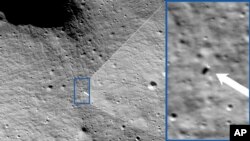Odysseus, the first U.S. spacecraft to land on the moon in half a century, was "still kicking" on Thursday but nearing shutdown, as scientists watched out for the final signals from its multimillion-dollar mission to collect data.
The spacecraft touched down on the lunar surface a week ago, and its operators had hoped it could run for up to 10 days. But an awkward sideways landing disrupted communications and affected its solar chargers.
The final word on its fate will come from Texas-based Intuitive Machines, the company that NASA paid $118 million to build the robot lander and fly it to the lunar surface. At 10:20 a.m., Intuitive said Odysseus was still operating, and flight controllers intend to download additional data and configure the lander to "phone home" if it gets more solar power following a three-week slumber through the frigid lunar night.
NASA has said it managed to extract some data from all six of its science payloads, although it remains to be seen how much information the agency and half a dozen commercial payloads lost.
The Nova-C-class lander, standing 4 meters (13 feet) tall, was launched on Feb. 15 from NASA's Kennedy Space Center in Florida on a Falcon 9 rocket supplied by SpaceX. It started orbiting the moon six days later.
The six-legged vehicle reached the lunar surface on February 22 after an 11th-hour navigational glitch and descent that ended with Odysseus landing in a sideways or sharply tilted position, immediately impeding its operations.
Intuitive Machines said the next day that human error was to blame for the navigational issue.
Flight readiness teams had neglected to manually unlock a safety switch before launch, preventing subsequent activation of the vehicle's laser-guided range finders and forcing flight engineers to hurriedly improvise an alternative during lunar orbit.
An Intuitive executive told Reuters on Saturday that the safety switch lapse stemmed from the company's decision to forgo a test-firing of the laser system during pre-launch checks in order to save time and money.
Whether or not failure of the range finders and last-minute substitution of a work-around ultimately caused Odysseus to land askew remained an open question, according to Intuitive officials.
Nevertheless, the company said last Friday that two of the spacecraft's communication antennae were knocked out of commission, pointed the wrong way, and that its solar panels were likewise facing the wrong direction, limiting the vehicle's ability to recharge its batteries.
As a consequence, Intuitive said on Monday that it expected to lose contact with Odysseus on Tuesday morning, prematurely terminating the mission.
NASA chief Bill Nelson told Reuters on Tuesday Odysseus apparently landed beside a crater wall and was leaning at a 12-degree angle, though it was not clear whether that meant 12 degrees from the surface or 12 degrees from an upright position.
Intuitive executives said on February 23 that engineers believed Odysseus had caught the foot of one of its landing legs on the lunar surface as it neared touchdown and tipped over before coming to rest horizontally, apparently propped up on a rock.
An image from an orbiting NASA spacecraft released on Monday showed the lander as a tiny speck near its intended destination in the moon's south pole region.
Odysseus became the first U.S. spacecraft to land on the moon since NASA's last crewed Apollo mission to the lunar surface in 1972.
It was also the first lunar landing ever by a commercially manufactured and operated space vehicle, and the first under NASA's Artemis program, which aims to return astronauts to Earth's natural satellite this decade.
To date, space agencies of just four other countries have ever achieved a "soft" moon landing — the former Soviet Union, China, India and, just last month, Japan, whose lander likewise tipped over on its side.
The United States is the only country ever to have sent humans to the lunar surface.












